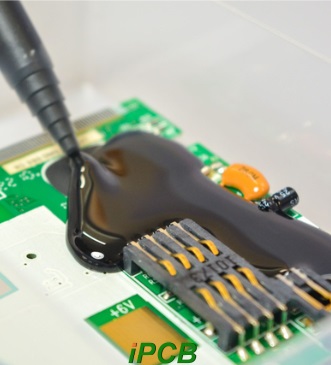What is a potting pcb?
PCB potting refers to the application of a potting compound, typically a liquid resin or polymer, to a PCB. It protects the PCB from water, dust, and harmful chemicals that could damage the PCB and its components. By completely covering the PCB, potting ensures its proper function even under harsh conditions.
Potting uses various materials, such as epoxy, silicone, polyurethane, and acrylic. These materials are chosen for their excellent protection against electrical shock and their ability to withstand environmental hazards. These potting compounds can be tailored to the needs of the PCB, with varying thicknesses, drying times, and heat resistance.
The Importance of PCB Potting Compounds
Environmental Protection
One of the primary functions of potting compounds is to protect PCBs from environmental factors. Moisture, dust, and chemicals can cause corrosion and short circuits, leading to device failure. Potting compounds create an airtight seal around the PCB, preventing these elements from contacting sensitive components.
Mechanical Stability
PCBs are often subjected to mechanical stresses such as vibration and impact. Potting compounds provide a cushioning effect, absorbing shock and vibration that could otherwise damage delicate circuitry. This is especially important for automotive, aerospace, and industrial applications, where devices are exposed to harsh conditions.
Thermal Management
Heat dissipation is a crucial aspect of PCB design. Potting compounds can help manage heat by conducting heat away from sensitive components, preventing overheating. Some potting materials are designed with high thermal conductivity to enhance this cooling effect.
Electrical Insulation
Potting pcb compounds also act as electrical insulators, preventing electrical interference between components. This is crucial for maintaining circuit integrity and ensuring devices operate as intended. Potting compounds help maintain optimal electrical performance by providing a consistent dielectric barrier.
Types of Potting PCBs
Each type of potting compound offers unique advantages and is suited to specific applications. The main types of potting compounds include:
1. Epoxy Compounds
Epoxy resins are widely used for potting because they are good insulators and very strong. They adhere well to various surfaces and are a barrier to chemicals and water. The thickness and drying time of epoxies can be varied, making them versatile.

2. Polyurethane Compounds
Polyurethane potting compounds offer a good balance between flexibility and durability. They offer strong resistance to chemicals, abrasion, and impact. Their flexibility makes them suitable for applications where PCBs may move or expand thermally. Polyurethanes are commonly used in consumer electronics and telecommunications equipment.
3. Silicone Compounds
Silicone potting compounds are highly flexible and have excellent thermal stability, making them ideal for high-temperature applications. They also offer good moisture resistance and electrical insulation. Silicones are often found in aerospace, automotive, and medical equipment, where temperature fluctuations occur.
4. Acrylic Compounds
Acrylic potting compounds are known for their ease of use and fast cure times. They offer good electrical insulation and are environmentally friendly. Acrylics are often used in applications requiring quick turnaround, such as consumer electronics and lighting.
Can potting compounds be removed or reworked?
Commonly used in electronic and electrical applications, potting compounds are materials designed to encapsulate components to protect them from environmental factors such as moisture, vibration, and shock. While potting materials are often selected for their durability and stability, removal or rework may be necessary in certain circumstances. Removing or reworking potting materials can be a challenging task due to their intended durability and potential damage to underlying components. However, with the proper techniques and tools, it is possible.
One method of removing potting compound involves mechanical methods such as scraping, grinding, or milling. This method is labor-intensive and carries the risk of damaging delicate parts. Another option is to use chemical solvents specially formulated to dissolve the potting material without harming the components. Solvent-based removal requires careful consideration of compatibility with the potting compound and its encapsulating material.
In some cases, localized heating can soften the potting compound, making it easier to remove. However, excessive heat can damage sensitive components or trigger chemical reactions in the potting material, resulting in undesirable byproducts or fumes.

Applications of Potting PCB Adhesives
PCB potting is used in many areas where electronics must withstand harsh conditions or operate under unusual conditions. Here are some examples of where you might find it:
Automotive Electronics: Cars and trucks require electronics that can withstand extreme heat or cold, significant movement, and humidity. Potting ensures these components remain secure and function properly, regardless of road conditions. Aerospace and Defense: Electronic equipment in aircraft and military equipment must operate at high altitudes, in extreme cold, or in environments subject to rapid movement and intense vibration. Potting ensures these critical components fail-safe. Industrial Equipment: Machinery in factories may be exposed to dust, chemicals, and constant vibration. Potting protects the electronics within, helping everything run smoothly and reducing the chance of failure. Consumer Electronics: Everyday electronics may not face extreme conditions, but potting can still protect them from spills, dust, and everyday impacts. This results in longer lifespans and better performance.
Potting pcbs is crucial in manufacturing electronic devices because it protects them, extends their lifespan, and ensures they properly block electrical current. When choosing a potting material, consider the device's needs, where it will be used, how long it takes for the material to cure, and your budget. iPCB is committed to providing professional potting solutions, offering technical support from material selection to process implementation, helping you enhance the quality and durability of your products. If you have any questions, please feel free to contact our team for efficient and reliable service.